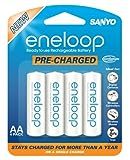
keep on goingLaptops have never been faster, cell phones never fancier, and plug-in electric cars are just around the corner. But batteries are not keeping up.
Computer chips double in speed every two years but the batteries powering those devices are improving by only about 8 percent a year. Across the country, an industry is working to reinvent the humble battery.
“Everybody is screaming for more power,” says Michael Thackeray, a battery expert with Argonne National Laboratory. It’s not just about gadgets. Many of today’s big issues—like reducing dependence on foreign oil, or greening the electricity supply with solar and wind power—depend on a device invented two centuries ago.
The world’s $71 billion battery market, once an old-tech backwater, is becoming a hothouse for innovation. The flow of U.S. venture-capital dollars into battery development has grown from $4.3 million in 2002 to more than $200 million this year, according to Dow Jones VentureSource. Even major players like General Electric and ExxonMobil are investing in the battery business. The hybrid- and electric-car-battery market alone is on course to grow nearly fivefold by 2015, to $3.7 billion, according to consultant Menahem Anderman. With billions pouring in, the industry now has the most attention it’s seen in decades.
Batteries still won’t evolve as quickly as computer-based technologies. The reason: a battery is based on a chemical reaction, which is limited by the laws of physics and the periodic table. Since Italy’s Alessandro Volta first came up with the idea in 1800, batteries have generated electricity using the same basic principle. A controlled chemical reaction takes place inside a series of cells, each of which has a negative and positive electrode, divided by a separator soaked in conductive electrolyte. When the battery is hooked up, positively charged ions swim from the negative to the positive electrode, and then negatively charged electrons pass through an external circuit, creating electric current. In 1890, Thomas Edison reversed this process and created the first rechargeable nickel-based batteries. Since then, scientists have tinkered with the chemistry to amp up the energy, creating lead-acid to start cars, nickel-cadmium to fire up early laptops and nickel-metal-hydride to power the Prius and other hybrid cars.
Today’s cutting-edge lithium-ion batteries first showed up on Sony’s brick-size cell phones in 1991. Lithium, the lightest metal on the periodic table, packs a lot of energy into a lightweight battery, but it has its downsides. Price is one of them: lithium-ion batteries currently cost twice as much as nickel-metal-hydride, which is why GM says its plug-in Chevy Volt could cost nearly $40,000 when it hits the streets in late 2010. Still, lithium-ion remains the hot new battery chemistry—maybe too hot. By generating so much voltage in a small space, lithium-ion’s chemical reaction can overheat and create what the engineers call “thermal runaway”—a phenomenon consumers call a “small explosion.”
The safety issues first gained notice two years ago, when laptops from Dell and other brands began catching fire. Thomas Forqueran, a gold miner in Kingman, Ariz., watched his laptop combust inside his pickup truck, igniting the truck’s gas tank and the shotgun shells in his glove box. “We saw flames 5, 6, 10 feet shooting out of the passenger window,” says Forqueran. Those safety problems led to recalls, so researchers are proceeding gingerly before installing next-gen batteries in devices we keep in our garages and pockets. “A couple bad accidents could give [new batteries] a black eye very easily,” says J. B. Straubel, technology chief at Tesla, the electric-car company.
For a look into what the battery-powered future might hold, however, the Johnson Controls research lab is a good place to start. The company’s lithium-ion production line is sealed off in a climate controlled “dry room.” While technicians mix a slurry of chemicals that are applied to thin sheets of copper and rolled through a drying oven, a computer monitors the room’s humidity and dew point. Moisture is a big problem in battery making—it can contaminate the chemicals and increase risks of a thermal runaway. No more than eight workers are allowed in the room at a time, says battery engineer Jim Symanski, because too much exhaled water vapor could harm these newborn batteries.
At Johnson, much of the excitement revolves around the promise of how better batteries could fuel a new generation of cleaner cars, which could help reduce America’s dependence on foreign oil. In a garage off the back of the lab, senior VP Mary Ann Wright keeps a Ford Escape Hybrid, which she engineered while working at Ford. When she arrived at Johnson Controls, she and some co-workers replaced its nickel-metal-hydride batteries with lithium-ion. The old batteries weighed 192 pounds versus 130 pounds for the new ones, which yield more power. The result: her jury-rigged Escape gets off-the-charts mileage. Prius owners who’ve done plug in lithium-ion conversions say they get 80mpg, and some analysts believe GM’s Volt could break 100mpg.
There’s groundbreaking research happening inside other U.S. companies as well. In Watertown, Mass., A123Systems has received $148 million in venture funding to create advanced batteries. It already makes rechargeable batteries for Black & Decker tools and is in the running to power GM’s Volt. EnerDel, an Indianapolis startup, is supplying batteries to Think electric cars in Europe. The government plays a role too: both Argonne and Oak Ridge national laboratories have teams working on advanced batteries. Researchers are coming up with new chemistries and employing nanotechnology to make lithium-ion safer and more reliable. A123’s battery, for example, employs nanophosphate technology that helps prevent thermal runaway and improve battery life. The trade-off: many of these alternative chemistries also lower the battery’s voltage.
While U.S. battery makers play catch-up, the Japanese battery industry is consolidating: Panasonic, Toyota’s battery supplier, is in talks to acquire Sanyo, Honda’s battery maker. South Korea has also demonstrated battery savvy, as does China, where the iPhone batteries are assembled. For some observers, this is a cause for concern. “Are we trading our dependence on foreign oil for a dependence on batteries built in foreign countries?” asks Chrysler vice chairman Jim Press.
To store energy generated by giant solar and wind installations, some utilities are experimenting with sodium-sulfur batteries that are the size of tractor-trailers. As more homeowners put solar panels on the roof and wind turbines in the backyard, utilities are trying to scale down these superbatteries; right now, however, it would require a battery the size of a nice bathroom to take your home “off the grid” with wind and solar power. Researchers are looking into thin-film batteries, but they’re costly and hard to mass-produce.
Optimists are confident that those challenges can be overcome. They envision a day when your electric car helps store the power generated by your rooftop solar panels, with many homeowners selling homegrown electricity back to the utility companies over the grid. This vision of energy nirvana sounds great to Molinaroli, who runs Johnson Controls’ battery business, but you’ll excuse him if he’s a bit jaded. “If you went behind the curtain at our tech center, you could probably find electric-vehicle projects from 10 years ago, 20 years ago, 30 years ago,” he says. “There’s a lot of skepticism.” But this time, with billions riding on battery breakthroughs, there’s hope the electric economy might finally come to light.